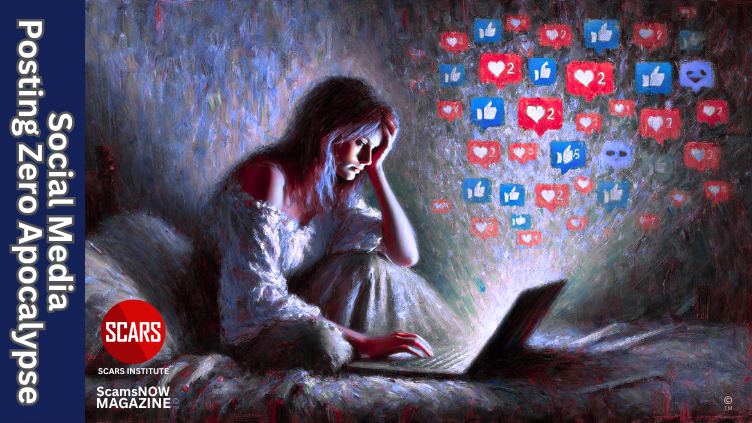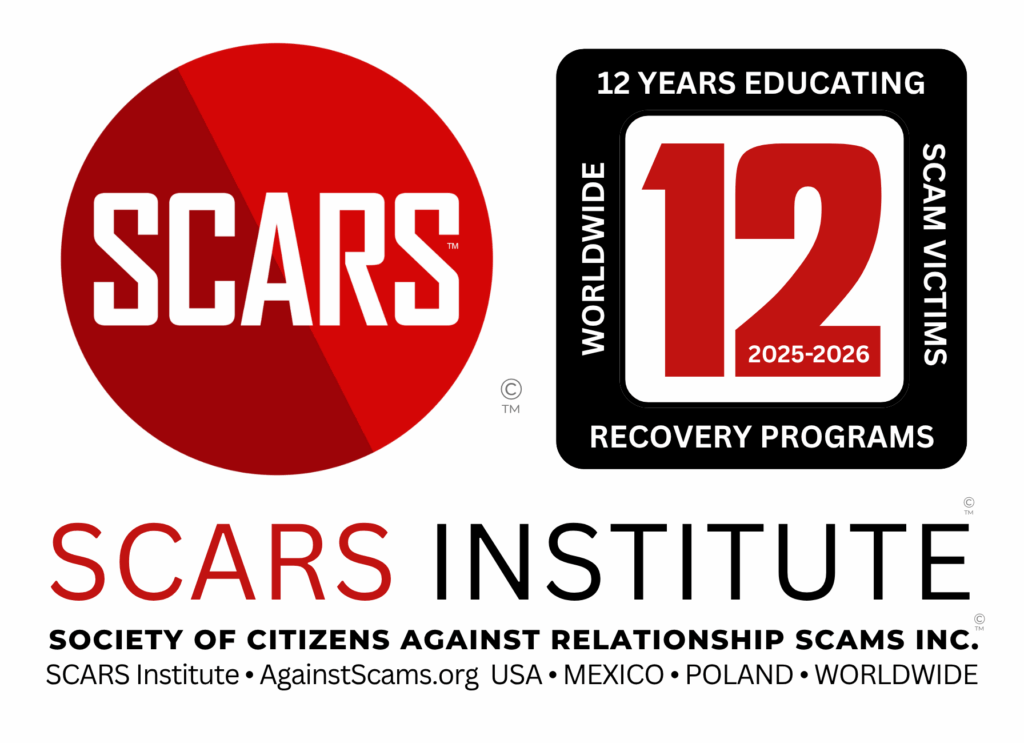
The Social Media ‘Posting Zero’ Apocalypse – The End of Posting and Commenting Online
Posting Zero: How Social Media Burnout and Risk Awareness Are Silencing Scam Survivors
Primary Category: Psychology / Sociology
Authors:
• Tim McGuinness, Ph.D., DFin, MCPO, MAnth – Anthropologist, Scientist, Polymath, Director of the Society of Citizens Against Relationship Scams Inc.
Author Biographies Below
About This Article
Social Media posting zero describes a rising pattern in which users read but do not publish, driven by fatigue, reputational risk, platform volatility, and privacy concerns. For scam survivors, that silence often hardens into isolation, as fear of stigma, retaliation, and doxxing discourages public sharing just when guidance and connection matter most. Victim service providers face parallel pressures, scaling back open posts amid impersonation, spam, and heavy moderation workloads, which thins the flow of trustworthy information. The result is a spiral where criminals exploit gaps with fake recovery offers and new frauds. A safer path relies on smaller, moderated rooms, layered identities, question-led exchanges, delayed disclosure, and steady routes to private counseling and verified resources. Providers can respond with fewer, stronger updates that point to stable libraries, closed webinars, trauma-informed moderation, and diversified channels beyond large social platforms. Posting zero can coexist with support when design favors dignity, safety, and practical action over reach.
Note: This article is intended for informational purposes and does not replace professional medical advice. If you are experiencing distress, please consult a qualified mental health professional.

Posting Zero: How Social Media Burnout and Risk Awareness Are Silencing Scam Survivors
A quiet trend is reshaping life online. People open apps, read, and leave without publishing a word. Drafts sit untouched. Feeds grow sparse while closed chats gain activity. Comment threads feel thinner and less generous. This pattern reflects a mix of fatigue, distrust, privacy concerns, and the sense that public posting now carries more downside than benefit. Observers have begun to call this pattern posting zero. The phrase captures both a protective instinct and a cultural shift. It also describes a growing barrier for online scam survivors who need clear information and human connection to recover. When the voices that could help go quiet, isolation grows and risks rise.
Social Media Burnout:
Social media burnout is a state of emotional and mental exhaustion caused by excessive or prolonged use of social media platforms. It is characterized by feelings of overwhelm, frustration, anxiety, and disengagement from social media activities.
Posting Zero:
A term being used to describe the growing tendency of people to no longer post or comment on social media
The Shape of Posting Zero
Social Media Posting Zero does not always look like a full account deletion. More often, it looks like quiet resistance to the demands of performative sharing. A user logs in, scrolls for a few minutes, and logs out without pressing publish. They save an idea in drafts and never return. They keep a profile alive for direct messages but scrub their history. They follow a handful of trusted accounts, turn off notifications, and stop tagging themselves in locations. The timeline becomes a one-way mirror.
The reasons are not complicated. People have learned that public posts can linger, that context gets lost, and that strangers can weaponize a short clip or a vulnerable sentence. They have watched friends pulled into pile-ons and learned that algorithmic reward favors hot takes over care. They know that scammers, data brokers, and automated scrapers harvest whatever lies in plain sight. When daily life already requires attention and care, risk without clear benefit feels unreasonable. The result is a growing preference for private channels and smaller rooms, along with a widening reluctance to publish personal details.
The Forces Behind It
Several forces propel posting zero, and each one hits survivors with special force.
The first is reputational risk. Public posts do not forget. Fragments can be lifted out of context and used to shame or mislead. Survivors know this better than most. Criminals who manipulated private emotions once can return with threats or impersonations. A short note that seems harmless may contain details that allow renewed contact. The prudent choice often feels like silence.
The second force is social cost. Victim blaming remains common. A survivor who reads comment sections learns how quickly strangers declare that only foolish people fall for fraud. That reflex ignores years of research about manipulation tactics, hormones, cognitive shortcuts, and professional scripts. It still stings. Many victims decide that the least painful choice is to read in private and never press publish.
The third force is platform volatility. Safety tools arrive late. Impersonators evade weak checks. Reporting systems remove a fake account only for another to appear in hours. When survivors face those cycles during a fragile time, public posting no longer looks like outreach. It looks like exposure.
The fourth force is exhaustion. Scam recovery demands energy. Banking calls, police reports, password changes, credit freezes, and counseling drain attention. Even supportive replies add a new layer to manage. A survivor who is trying to sleep, eat, and work cannot also monitor a busy thread. Quiet makes sense.
The fifth force is professional and family concern. Public posts can drift into work, school, or custody matters. People fear unwanted questions at the office or at a child’s activity. Silence feels safer than any attempt to manage visibility settings that keep changing.
These pressures not only shape individual choices, they also reach organizations that serve victims. Many providers report that open platforms now require constant defense against fake accounts, phishing links, and hostile replies. Moderation takes hours that could have gone to casework or education. Algorithms reduce reach for safety content while raising the cost of promotion. Impersonators copy logos and solicit money. Each new takedown follows the same steps and erodes public trust. In response, some providers post less often in public feeds and invest more in email, webinars, and closed groups. The result is predictable. Information becomes more accurate inside smaller rooms, yet harder to find for someone who is alone and searching.
The net effect is a spiral. Survivors avoid posting because public space feels unsafe. Providers publish less because public space requires constant defense. The threads that once carried lived experience grow thin. Rumors fill gaps. Criminals take advantage of silence by promoting fake recovery services and new frauds that prey on fear. A dynamic that began as self-protection starts to produce harm.
Why Scam Survivors are Especially Vulnerable to Posting Zero
Scam survivors navigate an even more fragile terrain. Their experience blends financial harm with deep emotional injury. Shame, grief, and anger often arrive together, then repeat without warning. Public talk can invite victim blaming, amateur investigations, and unsolicited advice. Survivors know that criminals scout support spaces to identify targets for re-victimization, extortion, or manipulation. Many have already been lied to under a false name and false story, so trust is both necessary and difficult.
Several Factors Drive Survivors Toward Silence
Fear of exposure and retaliation
Criminals monitor open platforms. They recycle names, images, and story fragments to lure new targets, or to pressure those who try to leave. Survivors who post details risk renewed contact, abusive messages, or doxxing. Even a careful summary can reveal just enough to attract attention. Faced with that possibility, many choose quiet over outreach.
Anticipation of stigma
Victim blaming remains a persistent social habit. Comments such as “how could anyone fall for that” or “I would never” harm recovery, even when posted by people who believe they are offering tough love. Survivors who have read these threads over time learn to avoid the risk by not posting at all.
Platform volatility
Terms of service change, safety tools lag behind coordinated abuse, and content moderation can feel inconsistent. Ban evasion and sockpuppet accounts allow criminals to return quickly. A survivor who has been burned once online becomes cautious about seeking help in a space that may fail to protect them twice.
Fatigue and cognitive overload
Trauma drains focus. Reporting, banking calls, password resets, and the work of rebuilding routines leave little energy for public conversation. Even supportive replies can feel overwhelming to process. A survivor may want connection but lack the bandwidth to manage a busy thread.
Professional and family concerns
A public account can intersect with employment, school, custody issues, or community roles. Survivors often fear that sharing will spill into realms where they prefer privacy. Posting nothing feels like the safest choice.
Why Providers are Scaling Back Public Posting
Victim service providers face a related pressure. Their teams must balance outreach with safety, and they must protect their communities from waves of scams that now travel through comments, direct messages, and fake lookalike accounts. Several realities shape their decisions to reduce open posting.
Moderator workload has spiked
As audiences grew, so did spam, abusive replies, and phishing links placed under high-traffic posts. Screening, deleting, and banning consumes staff time that could be used for casework or education. Smaller teams cannot keep pace without burning out.
Impersonation has increased
Criminals clone logos and names to solicit money, sell fake recovery services, or lure survivors into new traps. Each impersonation requires takedown requests and warnings, which erode trust and exhaust staff.
Algorithmic reach has declined, while risk has risen
Platforms often reduce organic reach for safety-related content, then offer paid promotion as a remedy. Providers face a paradox. Paying for reach can place sensitive posts in front of broad, non-targeted audiences, which increases trolling and misinterpretation. Remaining organic keeps risk lower but limits impact.
Legal and ethical safeguards demand caution
Publishing survivor stories requires consent, de-identification, and trauma-informed review. In fast-moving spaces, shortcuts create harm. Many providers prefer newsletters, webinars, or closed groups where consent and privacy can be honored properly.
Posting Zero and the Spiral of Isolation
For scam survivors, the silence of posting zero can become a spiral. They need living examples of recovery to counter self-blame, yet they do not see those examples as often in public feeds. They need to ask questions without being shamed, yet they watch other victims receive harsh replies. They need timely warnings about new tactics, yet they miss them because they avoid platforms. Service providers, facing similar pressures, publish less frequently. The net result is a thinner safety net just when fraud tactics are becoming more sophisticated.
Breaking the spiral requires a shift in strategy, not a return to reckless sharing. Survivors and providers can maintain caution while restoring communication through smaller, safer channels and structured habits.
A Practice-Based Path Forward for Survivors
The following practices help survivors benefit from their community without exposing more than necessary. Each step respects privacy, limits risk, and keeps attention on healing rather than performance.
Choose smaller private rooms/groups
Prefer moderated forums, vetted peer groups, and provider-hosted communities that require registration and adhere to a clear code of conduct. Smaller rooms reduce drive-by comments, allow firm moderation, and make it easier to ban impersonators.
Use layered identities
Maintain a separate email and screen name for support spaces. Avoid posting legal names, addresses, or images that reveal locations. Keep a written record of which identity is used where, so that account recovery is possible without linking identities publicly.
Share by theme, not by detail
Describe the type of scam, the general timeline, and the lesson learned, rather than specific amounts, dates, or names. Focus on patterns and red flags. This approach informs others while reducing the risk of targeted retaliation.
Practice delayed disclosure
Wait before posting fresh pain. Time allows for perspective and reduces the chance of sharing information that criminals could use. When posting, review the text with a trusted supporter or counselor first.
Prefer questions to declarations
Ask for resources, checklists, or step by step guidance rather than publishing a full narrative. Questions invite help without forcing disclosure. They also keep threads practical and calmer.
Move sensitive exchanges off platform
When deeper support is needed, move to a provider’s intake process, hotline, or counseling session. Save public threads for general information and encouragement.
Set a posting cadence
Replace constant scrolling with a brief, scheduled check-in. For example, fifteen minutes twice a day to read updates from trusted sources, then disconnect. This habit reduces anxiety and limits exposure to harassment.
Maintain a personal safety checklist
Keep passwords unique, enable multifactor authentication, monitor account recovery options, and update privacy settings quarterly. A short checklist reduces cognitive load. Survivors can print it and review it with a supporter.
Keep a private recovery log or journal
Track actions completed, such as bank reports, police case numbers, password resets, and counseling appointments. A written log steadies the mind when online noise becomes stressful and replaces public posting as a way to mark progress.
Use provider libraries
Rely on regularly updated articles, glossaries, and tutorials from reputable organizations. Reading and printing key pages often does more for recovery than chasing answers in volatile comment threads.
Safer Communication Design for Providers
Providers can remain present without exposing their communities to unnecessary risk by adopting a layered approach to outreach.
Publish less, say more
Replace frequent short posts with fewer, well-structured updates that point to a stable knowledge base. A clear title, a short summary, and a link to a printable guide help survivors act without diving into comments.
Shift engagement into vetted spaces
Host monthly live sessions in closed webinar rooms with pre-registration, waiting rooms, and active moderation. Record the sessions and offer an edited version that removes identifying details.
Build a resource spine
Maintain a central library of pages that answer common questions, such as “first steps after a scam” (SCARS Institute has this at www.ScamVictimsSupport.org), “how to report” (SCARS Institute has this at reporting.AgainstScams.org), and “how to stop contact and end a scam” (SCARS Institute has this at www.ScamVictimsSupport.org). Keep each page updated and date-stamped. Public posts should direct readers back to this spine.
Moderate with trauma-informed clarity
Publish a visible code of conduct. Remove victim-blaming comments quickly. Block impersonators. Offer a simple reporting form for suspected abuse. Trauma-informed moderation protects survivors and deters opportunists.
Use controlled feedback channels
Invite questions through a form rather than public replies, then publish an anonymized Q and A article or newsletter that addresses themes without exposing identities.
Coordinate with platforms
Verify organizational accounts (not always possible), monitor for lookalikes, and pre-draft takedown language for rapid response. Share fraud warnings with platform safety teams to accelerate action against malicious actors.
Diversify beyond large networks
Cultivate email newsletters, SMS alerts, and community messaging apps that allow smaller groups and clearer permissions. These channels provide continuity when algorithms change or when harassment spikes.
Protect staff
Set clear rotation schedules for moderators, offer debriefs after difficult incidents, and provide mental health resources. Staff resilience supports survivor safety.
Designing a Culture that Works Without the Feed
Posting zero signals a cultural need that aligns with survivor safety. People want connection without constant performance. They want information without surveillance. They want support that feels human, not viral. Meeting these needs requires a move from the wide stage of public feeds to the steadier ground of small rooms, print-friendly guides, and predictable events.
A survivor-centered communication culture can include the following elements.
A predictable calendar
Monthly themes, such as reporting, emotional first aid, financial recovery, and relapse prevention, create rhythm. Survivors know what to expect, providers plan content more calmly, and re-victimization attempts are easier to spot because off-topic posts stand out.
A shared vocabulary
Glossaries that define terms like impersonation, pig butchering, deepfake, account takeover, and trauma response reduce confusion. When communities use the same language, misinformation loses power.
A layered welcome
Newcomers enter through an orientation that explains privacy practices, safety settings, and available services. Orientation reduces risky behavior and sets norms without public correction.
A gratitude practice based on action
Survivors and providers can celebrate small acts that keep communities safe, such as reporting a fake profile, updating a resource page, or attending a support session. Recognition strengthens connection without rewarding oversharing.
A channel for private courage
Anonymous success notes, collected by providers and published with consent, give survivors hope without exposing anyone. A line as simple as “I blocked contact today and slept better” can help another person take the same step.
Responding to the Future of Attention
Fraud strategies evolve. AI-assisted phishing, voice cloning, and real-time deepfakes complicate verification and heighten anxiety. In that environment, posting zero will likely persist as a rational response for many users. Survivors need not fight that tide by forcing themselves into public exposure. Instead, they can work with the current by seeking support in places designed for safety, by using habits that protect their privacy, and by measuring progress through consistent action rather than likes or shares.
Victim’s Service Providers can adapt by treating social media as a doorway rather than a destination, by building strong audiences beyond the feed, and by maintaining relationships with platform safety teams. The goal is not volume. The goal is trust that outlasts the news cycle.
A Closing View
Posting zero does not signal apathy. It signals caution and a shift in values. People are learning that silence in public can protect attention, dignity, and safety. For scam survivors, that instinct is understandable, yet silence should not become isolation. Recovery improves when questions reach trained listeners, when warnings arrive in time, and when practical steps feel clear.
The way forward blends smaller rooms with steady information, careful privacy with real connection, and fewer posts with stronger support. Survivors deserve spaces where they can learn without fear, speak without spectacle, and heal without performing. Providers deserve tools and workflows that protect their teams and their communities while keeping communication open. Social platforms will continue to change, but the need for humane, secure channels will not. Posting zero can coexist with strong support when communities choose design over impulse and care over reach.
More about this: https://www.bbc.com/worklife/article/20250722-social-media-user-changes-kyle-chayka-katty-kay-interview

Glossary
- Algorithmic reach — This refers to how many people a platform shows a post to without paid promotion. Lower reach for safety content means survivors may miss credible warnings unless providers point to stable resources. Planning for low reach helps communities avoid relying on virality.
- Anonymous Q and A — This describes a method where questions arrive privately and answers are published without names. It protects dignity while spreading practical guidance. Providers use it to reduce exposure and limit hostile replies.
- Anonymous success note — This is a short, unnamed update that marks a recovery step, such as blocking contact or filing a report. It offers hope without revealing identity or details. Providers can collect and share these notes with consent.
- Ban evasion — This is the tactic where a banned user returns with a new account to continue abuse or scams. It raises risk in open comment sections. Firm moderation and smaller rooms reduce this problem.
- Boundary setting (online) — This means deciding what to share, where to share it, and what to keep private. Clear boundaries reduce exposure to harassment and re-victimization. Survivors and providers both benefit from written posting rules.
- Closed room/group — This is a member-only space with admission controls and active moderation. It limits drive-by abuse and impersonation. Smaller rooms make it easier to enforce safety policies.
- Code of conduct — This is a posted set of rules for respectful participation. It guides moderation and sets expectations before problems arise. Trauma-informed codes explicitly ban victim blaming and solicitation. The SCARS Institute Code of Conduct can be found at www.AgainstScams.org
- Consent baseline — This is the standard that stories are only shared with informed permission and careful de-identification. It prevents harm from rushed publicity. Providers build consent steps into intake and editing.
- Content volatility — This describes how fast discussions shift and how quickly harmful replies can spread. Volatility increases stress for survivors. Slower lanes like newsletters and webinars reduce that strain.
- Controlled feedback channel — This is a form or inbox used instead of public replies. It filters out spam and phishing links. It also lets staff respond thoughtfully and protect private details.
- Delayed disclosure — This is the practice of waiting before posting about fresh events. Time creates perspective and reduces accidental oversharing. It also frustrates criminals who watch for live details.
- Digital safety checklist — This is a short list of routine actions such as unique passwords, multifactor login, and recovery-option reviews. A checklist lowers cognitive load during stressful weeks. Printing it keeps progress visible.
- Doxxing — This is the exposure of private information, such as home address or workplace, without consent. It is used to intimidate survivors and staff. Limiting personal details online reduces this risk.
- Draft fatigue — This describes saving posts that never get published due to fear or exhaustion. It signals burnout and the need for safer channels. Moving questions into a closed room often unlocks needed support.
- Emotional first aid (online) — This is the immediate care that steadies someone after digital harassment or scam discovery. It includes breathing, short walks, and brief check-ins with trusted people. It prepares the mind for the next steps.
- Exhaustion spiral — This is the cycle where stress reduces posting, which reduces support, which increases stress. Naming the spiral helps teams redesign communication. Scheduled, limited check-ins can break the loop.
- Fake recovery service — This is a scam that targets victims with promises to recover lost funds for a fee. It exploits silence and fear. Clear warnings in trusted channels reduce losses.
- Feed fatigue — This is the tiredness that follows constant scrolling and monitoring. It weakens attention and heightens anxiety. A fixed reading window and fewer accounts restore focus.
- Harm-minimizing post — This is a message that teaches patterns and steps without revealing identifying details. It informs while protecting privacy. Providers can template these posts for consistency.
- Hot-take incentive — This is the platform reward for fast, provocative content. It harms nuanced safety education. Slower formats counter this pressure.
- Impersonation account — This is a fake profile that copies a survivor or provider brand to mislead others. Verification, watermarked graphics, and quick takedown requests reduce impact. Communities benefit from pinned warnings about lookalikes.
- Information drought — This is the gap that forms when credible voices post less and rumors replace guidance. It increases risk for isolated survivors. A resource library and periodic digests restore flow.
- Intake pathway — This is the private process for moving from public interest to direct support. It protects confidentiality and organizes next steps. Clear links to intake reduce risky oversharing.
- Isolation spiral — This is the widening separation that follows posting zero when no alternative support is in place. It increases exposure to repeat scams. Small, vetted groups counter isolation.
- Layered identity — This is the use of separate emails and screen names for support spaces. It keeps legal names and locations private. A written record of accounts prevents lockouts.
- Lurker safety — This is the choice to read without posting to limit risk. It becomes protective when paired with private counseling and vetted resources. It becomes harmful when it replaces all connection.
- Moderator workload — This is the time spent screening, deleting, and banning harmful content. High load drains teams and weakens outreach. Fewer, stronger posts and closed rooms reduce strain.
- Monthly theme — This is a planned focus, such as reporting steps, emotional care, or prevention. Themes create rhythm and predictability. They also make off-topic scams easier to spot.
- Notification hygiene — This is the practice of turning off nonessential alerts and using scheduled check-ins. It protects sleep and concentration. It also lowers the urge to react to hostile replies.
- Posting cadence — This is a planned schedule for brief, predictable engagement. It prevents endless scrolling. A short daily window preserves energy for recovery tasks.
- Posting zero — This is the pattern where users read but do not publish in public spaces. It reflects caution, burnout, and privacy concerns. Without safer alternatives, it can deepen isolation.
- Private channel — This is a nonpublic route for support, such as a closed forum, webinar, or hotline. It enables detailed help without exposure. Survivors gain clarity while staying off open feeds.
- Provider library — This is a stable set of pages and guides that answer common questions. It reduces reliance on volatile comment threads. Links from social posts should point back to this library.
- Question-led exchange — This is a conversation style that asks for resources and steps rather than full narratives. It invites help without forcing disclosure. It keeps threads practical and calmer.
- Reputational risk — This is the danger that a public post will be misread, archived, or used against the writer later. It weighs heavily on survivors and staff. Safer rooms and careful editing reduce this risk.
- Resource spine — This is the central, updated collection of core articles, checklists, and reporting links. It anchors all outreach. Fewer social posts can point back to this spine.
- Scheduled check-in — This is a fixed time to read trusted updates and then log off. It restores control over attention. It also limits exposure to harassment cycles.
- Shame barrier — This is the internal wall built by self-blame and hostile comments. It keeps survivors silent when support would help. Nonjudgmental spaces lower this barrier.
- Sockpuppet account — This is a deceptive profile used to steer conversations and harvest information. Admission controls and active moderation make them easier to spot. Quick bans protect the group.
- Stigma anticipation — This is the expectation of judgment that stops people from sharing. It grows after reading harsh comment sections. Trauma-informed rules and private channels counter this effect.
- Takedown protocol — This is a prewritten process for reporting impersonation and phishing under a brand. It speeds removal and calms staff. Posting the protocol internally prevents confusion.
- Trauma-informed moderation — This is the approach that removes blame, protects privacy, and explains actions clearly. It reduces harm while keeping spaces usable. Training and scripts support consistency.
- Trust over reach — This is the strategy that favors smaller, safer audiences rather than viral exposure. It suits sensitive topics and reduces re-victimization. Providers build trust through predictable formats.
- Username compartmentalization — This is the separation of handles across platforms to prevent linking identities. It protects privacy during recovery. A secure record of aliases prevents mistakes.
- Vetted space — This is a room where members are reviewed before entry, and rules are enforced. It reduces spam and predatory outreach. Survivors gain room to ask practical questions.
- Volatile platform risk — This is the hazard created by frequent policy shifts and weak safety tools. It can expose survivors twice. Diversifying channels reduces dependency on any single feed.
- Waiting-room control — This is the use of staging areas in webinars or meetings to screen entrants. It blocks impersonators and keeps sessions calm. It becomes standard for sensitive discussions.
- Whitelisted source — This is a trusted account or site placed on a personal allow-list. It cuts through noise and scams. Survivors can maintain a short list to focus limited attention.
- Zero-post footprint — This is a minimal public profile kept only for direct messages and reading. It becomes safer when combined with layered identity and private counseling routes. It should never be the only support strategy.
Author Biographies
Please Rate This Article
Please Leave Us Your Comment Below
Also, tell us of any topics we might have missed.
-/ 30 /-
What do you think about this?
Please share your thoughts in a comment above!
ARTICLE RATING
TABLE OF CONTENTS
CATEGORIES
U.S. & Canada Suicide Lifeline 988
![NavyLogo@4x-81[1] The Social Media 'Posting Zero' Apocalypse - The End of Posting and Commenting Online - 2025](https://scamsnow.com/wp-content/uploads/2025/04/NavyLogo@4x-811.png)
ARTICLE META
One Comment
Leave A Comment
Important Information for New Scam Victims
- Please visit www.ScamVictimsSupport.org – a SCARS Website for New Scam Victims & Sextortion Victims.
- SCARS Institute now offers its free, safe, and private Scam Survivor’s Support Community at www.SCARScommunity.org – this is not on a social media platform, it is our own safe & secure platform created by the SCARS Institute especially for scam victims & survivors.
- SCARS Institute now offers a free recovery learning program at www.SCARSeducation.org.
- Please visit www.ScamPsychology.org – to more fully understand the psychological concepts involved in scams and scam victim recovery.
If you are looking for local trauma counselors, please visit counseling.AgainstScams.org
If you need to speak with someone now, you can dial 988 or find phone numbers for crisis hotlines all around the world here: www.opencounseling.com/suicide-hotlines
Statement About Victim Blaming
Some of our articles discuss various aspects of victims. This is both about better understanding victims (the science of victimology) and their behaviors and psychology. This helps us to educate victims/survivors about why these crimes happened and not to blame themselves, better develop recovery programs, and help victims avoid scams in the future. At times, this may sound like blaming the victim, but it does not blame scam victims; we are simply explaining the hows and whys of the experience victims have.
These articles, about the Psychology of Scams or Victim Psychology – meaning that all humans have psychological or cognitive characteristics in common that can either be exploited or work against us – help us all to understand the unique challenges victims face before, during, and after scams, fraud, or cybercrimes. These sometimes talk about some of the vulnerabilities the scammers exploit. Victims rarely have control of them or are even aware of them, until something like a scam happens, and then they can learn how their mind works and how to overcome these mechanisms.
Articles like these help victims and others understand these processes and how to help prevent them from being exploited again or to help them recover more easily by understanding their post-scam behaviors. Learn more about the Psychology of Scams at www.ScamPsychology.org
SCARS INSTITUTE RESOURCES:
If You Have Been Victimized By A Scam Or Cybercrime
♦ If you are a victim of scams, go to www.ScamVictimsSupport.org for real knowledge and help
♦ SCARS Institute now offers its free, safe, and private Scam Survivor’s Support Community at www.SCARScommunity.org – this is not on a social media platform, it is our own safe & secure platform created by the SCARS Institute especially for scam victims & survivors.
♦ Enroll in SCARS Scam Survivor’s School now at www.SCARSeducation.org
♦ To report criminals, visit https://reporting.AgainstScams.org – we will NEVER give your data to money recovery companies like some do!
♦ Follow us and find our podcasts, webinars, and helpful videos on YouTube: https://www.youtube.com/@RomancescamsNowcom
♦ Learn about the Psychology of Scams at www.ScamPsychology.org
♦ Dig deeper into the reality of scams, fraud, and cybercrime at www.ScamsNOW.com and www.RomanceScamsNOW.com
♦ Scam Survivor’s Stories: www.ScamSurvivorStories.org
♦ For Scam Victim Advocates visit www.ScamVictimsAdvocates.org
♦ See more scammer photos on www.ScammerPhotos.com
You can also find the SCARS Institute’s knowledge and information on Facebook, Instagram, X, LinkedIn, and TruthSocial
Psychology Disclaimer:
All articles about psychology and the human brain on this website are for information & education only
The information provided in this and other SCARS articles are intended for educational and self-help purposes only and should not be construed as a substitute for professional therapy or counseling.
Note about Mindfulness: Mindfulness practices have the potential to create psychological distress for some individuals. Please consult a mental health professional or experienced meditation instructor for guidance should you encounter difficulties.
While any self-help techniques outlined herein may be beneficial for scam victims seeking to recover from their experience and move towards recovery, it is important to consult with a qualified mental health professional before initiating any course of action. Each individual’s experience and needs are unique, and what works for one person may not be suitable for another.
Additionally, any approach may not be appropriate for individuals with certain pre-existing mental health conditions or trauma histories. It is advisable to seek guidance from a licensed therapist or counselor who can provide personalized support, guidance, and treatment tailored to your specific needs.
If you are experiencing significant distress or emotional difficulties related to a scam or other traumatic event, please consult your doctor or mental health provider for appropriate care and support.
Also read our SCARS Institute Statement about Professional Care for Scam Victims – click here
If you are in crisis, feeling desperate, or in despair, please call 988 or your local crisis hotline.
More ScamsNOW.com Articles
A Question of Trust
At the SCARS Institute, we invite you to do your own research on the topics we speak about and publish. Our team investigates the subject being discussed, especially when it comes to understanding the scam victims-survivors’ experience. You can do Google searches, but in many cases, you will have to wade through scientific papers and studies. However, remember that biases and perspectives matter and influence the outcome. Regardless, we encourage you to explore these topics as thoroughly as you can for your own awareness.























![scars-institute[1] The Social Media 'Posting Zero' Apocalypse - The End of Posting and Commenting Online - 2025](https://scamsnow.com/wp-content/uploads/2025/04/scars-institute1.png)
![niprc1.png1_-150×1501-1[1] The Social Media 'Posting Zero' Apocalypse - The End of Posting and Commenting Online - 2025](https://scamsnow.com/wp-content/uploads/2025/04/niprc1.png1_-150x1501-11.webp)

Well said, I agree with everything. I find I am posting less, commenting less. It is fatiguing when someone misunderstands my comments, and then attacks. Definitely can put a recovery in jeopardy.